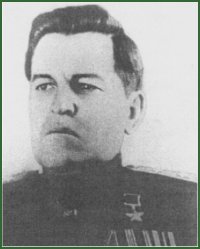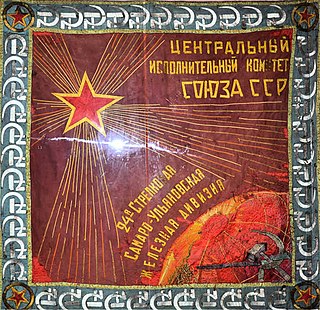The 4th Army was a Soviet field army of World War II that served on the Eastern front of World War II and in the Caucasus during the Cold War. It was disbanded after the fall of the Soviet Union, with its divisions being withdrawn to Russia and disbanded.
Transcaucasian Front or Transcaucasus Front was a front of the Soviet Red Army—a military formation comparable to an army group, not a geographic military front—during the Second World War.
The 289th Rifle Division was an infantry division of the Soviet Union's Red Army, formed twice. The division was first formed in the summer of 1941, after the German invasion of the Soviet Union, and was sent to the front and destroyed in the Battle of Kiev in September. The division was formed a second time in October 1941 from the 5th Rifle Brigade, a separate infantry brigade fighting in the Continuation War against Finnish and German troops in Karelia. The new division spent most of the war in Karelia and in the summer of 1944 fought in the Vyborg–Petrozavodsk Offensive, which resulted in the end of the Continuation War in September. The division was stationed at Belomorsk in Karelia until its disbandment after the end of World War II in July 1946.

The Transcaucasian Military District, a military district of the Soviet Armed Forces, traces its history to May 1921 and the incorporation of Armenia, Azerbaijan, and Georgia into the Soviet Union. It was disbanded by being redesignated as a Group of Forces in the early 1990s after the Soviet Union collapse. The military district formed as a basis of the modern day armed forces of Armenia, Azerbaijan, and Georgia.
The 79th Rifle Corps was a rifle corps of the Red Army in World War II that became part of the Soviet Army during the Cold War.
The 4th Rifle Division was an infantry division of the Soviet Union's Red Army, formed three times. It was first formed in 1919 from the remnants of the Lithuanian Rifle Division and fought in the Defence of Petrograd during the Russian Civil War. The division then fought in the Polish–Soviet War. In 1939, the division fought in the Soviet invasion of Poland. It fought in the Winter War from December 1939 and suffered heavy losses in the Battle of Kelja. After Operation Barbarossa, the division fought in the Barvinkove-Losowaja Operation and the 1942 Battle of Voronezh. It suffered heavy losses at Voronezh and was disbanded in November 1942. The division reformed in 1943 and fought in the Bryansk Offensive, Gomel-Rechitsa Offensive, Lublin–Brest Offensive, Warsaw-Poznan Offensive and Berlin Offensive. It was disbanded in the summer of 1945. The division was reformed a third time from the 160th Rifle Division and inherited that division's honorifics and awards. It became the 4th Motor Rifle Division in 1957 and disbanded in 1959.
The 47th Army of the Soviet Union's Red Army was an army-level command active from 1941 to 1946.
The 32nd Cavalry Division was formed in 1938 in the Kiev Military District from the 1st Zaporozhe Cossack Cavalry Division.
The 296th Rifle Division was an infantry division of the Soviet Union's Red Army during World War II, formed twice. Its first formation was formed in the summer of 1941 and destroyed during Case Blue, the German summer offensive in the North Caucasus, in 1942. Reformed in the summer of 1943 in Georgia, the division's second formation never saw combat and was disbanded in 1946.
The 276th Rifle Division was an infantry division of the Soviet Union's Red Army during World War II, formed twice.
The 271st Rifle Division was an infantry division of the Soviet Union's Red Army during World War II.

The 348th Rifle Division was first formed in August, 1941, as a standard Red Army rifle division, at Kuibyshev. It was assigned to 60th Reserve Army shortly after forming and took part in the winter counteroffensive in front of Moscow. Until the end of 1942 it was involved in the dismal and costly battles around the Rzhev Salient, until it was shifted to take part in the equally difficult fighting around the Demyansk Salient. Both of these German positions were evacuated in March, 1943, and, after rebuilding, the division returned to the front to take part in the summer offensive along the Smolensk axis. During Operation Bagration the 348th distinguished itself in the liberation of Bobruisk, and received the name of that city as an honorific. Not long after it was also decorated for its role in the liberation of Bialystok. In 1945 it helped to liberate northern Poland during the Vistula-Oder Offensive, before being reassigned to 3rd Belorussian Front in East Prussia. In the last weeks of the war it formed part of the reserves of 1st Belorussian Front during the Berlin Operation.
The 74th Anti-Aircraft Artillery Division was an anti-aircraft artillery division of the Soviet Union's Red Army during World War II and the early postwar period.

The 140th Borisov Order of Kutuzov Anti-Aircraft Missile Brigade is an air defense brigade of the Russian Ground Forces' 29th Army in the Eastern Military District, stationed at Domna in Zabaykalsky Krai.

The 402nd Rifle Division was raised in 1941 as an infantry division of the Red Army, and served throughout the Great Patriotic War in that role, but saw relatively little combat. It was raised as an Azerbaijani National division in the Transcaucasus Military District and first formed part of the occupation force following the Anglo-Soviet invasion of Iran. It returned to the USSR in April, 1942, remaining in the Caucasus region until the forces of German Army Group A began its drive on the oil fields there as part of Operation Blue. In October it joined the Northern Group in the Transcaucasus Front, in the 44th Army, defending the direct route to Baku. The division took part in the counteroffensive that threw the German forces out of the Caucasus, but took heavy losses in the process. Once the German threat receded the 402nd returned to guard duties along the border with Turkey and served as a training establishment for Azeri recruits for the duration of the war.
The 406th Rifle Division was raised in 1941 as an infantry division of the Red Army, and served throughout the Great Patriotic War in that role, but saw relatively little combat. It was raised as a Georgian National division in the Transcaucasus Military District, where it remained until the forces of German Army Group A began its drive on the oil fields there as part of Operation Blue. In August 1942 it joined the Northern Group in the Transcaucasus Front, in the 46th Army, defending the high passes through the High Caucasus Mountains west of Mount Elbrus. Once the German threat receded, the 406th returned to guard duties along the borders with Turkey and Iran for the duration of the war.

The 68th Mountain Rifle Division was a mountain infantry division of the Red Army before and during World War II.
The 5th Guards Don Cossack Cavalry Corps was a cavalry corps of the Red Army during World War II.
The 210th Rifle Division was formed as an infantry division of the Red Army after a motorized division of that same number was badly damaged and then redesignated as a cavalry division in the first weeks of the German invasion of the Soviet Union. It served through nearly the remainder of the war on a quiet sector in Transbaikal Front, entirely as part of 36th Army. During July 1945, in the leadup to the Soviet invasion of Manchuria, it was transferred to the 86th Rifle Corps, still in 36th Army. This Army was in the second echelon of the invading forces and saw very little, if any, actual combat, but the division was nevertheless given a battle honor. It was transferred to 17th Army and was disbanded with it by mid-1946.
The 51st Air Defense Division, abbreviated 51 dpvo, is an air defense formation of the 4th Air and Air Defence Forces Army of the Russian Aerospace Forces, which in turn is operationally subordinate to the Southern Military District. The headquarters is located in Novocherkassk.




